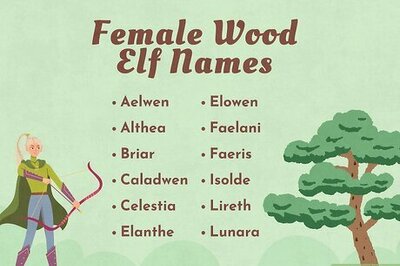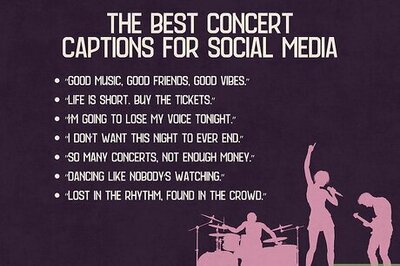
views
London: Italian designer Domenico Dolce appears in a magazine ad, one hand perched affectionately on the shoulder of his design partner and former lover Stefano Gabbana, the other holding his stylish new Motorola phone.
Whether it's US firm John Hancock featuring a lesbian couple in an ad for insurance or Altoids pitching two flavours of its "curiously strong mints" by asking readers if they are "bi-curious", big advertisers are storming out of the closet.
In part, the gay advertising boom reflects the lure of an underserved market: gay consumers are wealthier than average, and loyal to brands that they perceive as gay-friendly. In 1994, just 19 of the Fortune 500 companies advertised their brands in gay media in the United States.
Last year, 175 did, says Todd Evans of Rivendell Media, which places ads in gay US newspapers and magazines. And increasingly advertisers are also using gay themes to appeal to mainstream consumers.
"Most big agencies have looked at it," said Gordon MacMillan, editor of London's ad industry Internet newsletter Brand Republic.
"One, they are targeting the gay market. And two, they are targeting the straight market as well, who perceive the gay market as having a certain style or cachet." Advertisers have discovered that gay-friendliness is cool, said Michael Wilke, who tracks gay-themed advertising on a website, the Commercial Closet.
"They are looking to have a hip image, to say we are part of pop culture, and pop culture is increasingly inclusive of gays and lesbians."
Just a few years ago, before men's makeover show "Queer Eye for the Straight Guy" and sitcom "Will and Grace", openly gay people were rare on television. According to Wilke, the first US television ad to feature an ordinary gay couple was a 1994 Ikea spot showing two men shopping for a dining-room table.
The company ran it only at night and pulled it after getting bomb threats. Insurer John Hancock ran a ground-breaking television spot during the 2000 Olympics and World Series baseball championships, showing a lesbian couple adopting an Asian baby.
"Can you believe this? We're a family," says one. As the commercial ends, one says to the other: "You're going to be a great mom." The second replies: "So are you." But those final lines were edited out after the ad was shown just once, allowing some viewers to think the couple are meant to be sisters.
That same year, tennis star Martina Navratilova began appearing in Subaru car ads. Although the ads didn't discuss her sexuality, hiring an openly gay celebrity to pitch a mainstream product to mainstream consumers was seen at the time as risky.
"If they wanted to reach gays only, they had no reason to spend hundreds of thousand of dollars to create a TV commercial to run in prime-time television," said Wilke.
PAGE_BREAK
Today, gay celebrity endorsements are common. Talk show host Ellen DeGeneres pitches for American Express cards. Rock star Melissa Etheridge poses with her partner for Cartier jewellers, wearing interlocking bracelets designed for lesbian weddings.
"Queer Eye" in particular promotes its gay protagonists as style experts and is packed with grooming and fashion product placements.
Its stars have appeared in mainstream TV ads for products ranging from home furnisher Pier 1 to Diet Pepsi.
Advertisers are also getting more sophisticated in their approach to gay consumers. Rivendell Media says last year was the first time more than half the ads in gay US magazines and newspapers were created specifically for a gay audience.
Osmosis Medialab, a New York-based boutique firm specialising in gay advertising, has created campaigns for products like Mercedes cars, Casio cameras and Philips flat-screen TVs. Co-founder Shawn Thomson says he no longer has difficulty explaining to clients why they need his services.
"We launched the agency about eight years ago and there was a lot of education involved in the early days. Advertisers do see the value in this market now. People do seem to get it." With gays, as with straights, sex sometimes sells. Breweries, notorious for using half-naked women to sell beer to straight men, have adopted a similar approach in targeting gay men.
Budweiser has used visual puns on the suggestive shape of its long-necked bottle, with slogans like "nice package".
But increasingly, gays are looking for more serious messages of solidarity, expecting companies to support them by sponsoring gay community events or backing gay-friendly workplace policies.
Holiday Inn sponsored a gay pride event in Australia with an ad showing two pairs of men's shoes at the foot of a bed, and the tagline "Accommodating You."
Avis advertises that it lists gay partners as extra drivers on car rentals for free. "Showing that you're willing to take that extra step and actually support gay causes -- I think that's where advertisers really see a solid return on their investment," said Thomson.
Inclusive messages resonate not just with gays, but with a much larger gay-friendly audience, says Rivendell's Evans.
He points to an Absolut Vodka ad in People magazine that depicted the brand's trademark bottle in rainbow gay pride colours. "I'm the only gay person in my family. But that ad got someone like my mother to notice it."




















Comments
0 comment